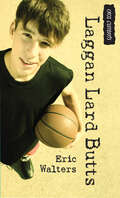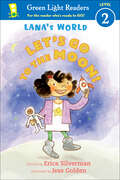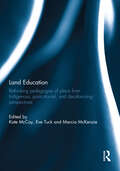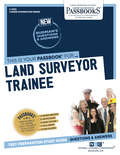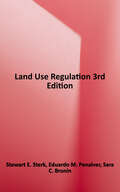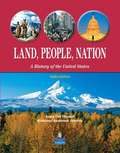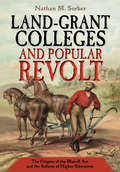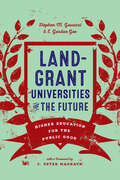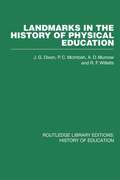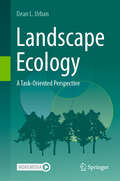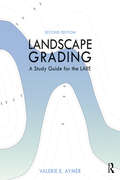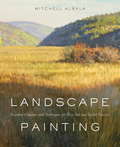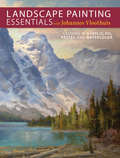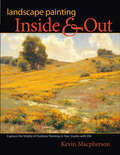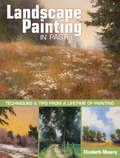- Table View
- List View
Ladybugs, Tornadoes, and Swirling Galaxies: English Language Learners Discover Their World Through Inquiry
by Brad Buhrow Anne Upczak GarciaBrad Buhrow and Anne Garcia are primary teachers in a diverse school in Boulder, Colorado. In Ladybugs, Tornadoes and Swirling Galaxies, you will see how they blend comprehension instruction and ELL best practices to explore inquiry as a literacy pathway for English language learners. As teachers and students engage in learning science and social studies content they also discover multiple ways to make meaning. The book is full of photographs of student artwork-including a color insert-that reveals the children's inquiry process, and demonstrates the important role of art as a sign system in ELL literacy and language acquisition. Brad and Anne provide explicit detail on the process they use as they move step-by-step with students from personal narrative through the independent inquiry process. They also discuss use of the Gradual Release Model, authentic assessment, and bilingual identities. Appendices in Spanish and English help to round out this informative and charming resource.
Laggan Lard Butts (Orca Currents)
by Eric WaltersSam Campbell's school team, the Laggan Lairds, always loses. When someone suggests that their name be the Laggan Lard Butts, Sam thinks the team should change its name. What is a Laird anyway? The basketball coach agrees, and soon the whole school is involved in an election for a new team name. Sam and his friends nominate the name Lard Butts. When the basketball team starts winning games after a warm-up cheer of "Go Lard Butts!" it seems the Lard Butt campaign might actually win the election. This short novel is a high-interest, low-reading level book for middle-grade readers who are building reading skills, want a quick read or say they don’t like to read!
Lamps and Lighting
by M.A. CaylessThis book is a comprehensive guide to the theory and practice of lighting. Covering the physics of light production, light sources, circuits and a wide variety of lighting applications, it is both suitable as a detailed textbook and as thoroughly practical guide for practising lighting engineers. This fourth edition of Lamps and Lighting has been completely updated with new chapters on the latest lamp technology and applications. The editors ahve called upon a wide range of expertise and as a result many sections have been broadened to include both European and US practice.The book begins with a description of the fundamentals of light, vision, colour and measurement. Part II, the main section of the book, deals with lamps and control equipment and includes descriptions of all lamp types in use today. Part III on lighting covers both interior and exterior applications.
Lana's World: Let's Go to the Moon (Green Light Readers Level 2)
by Erica SilvermanThe story of a little girl who wants to fly high, from the author of the Cowgirl Kate and Cocoa series!When little Lana suggests a family adventure to the moon, Papa, Mama, Jay, Ray, and even Furry the dog have excuses not to go. But that&’s not enough to stop the imaginative and resourceful Lana from rocketing into space and ultimately getting her whole family to blast off with her… Vroom! Zoom! Whoosh! Welcome to Lana&’s World!
Land Between the Rivers: Thoughts on Time and Place
by Todd R. NelsonTodd Nelson, a retired educator, builds upon the success of his critically acclaimed debut essay collection, Cold Spelll. In this new compilation, Nelson delves into his Maine experiences, weaving together a series of concise essays. Unlike the traditional focus on specific locations, these essays center around the art of observation. While readers will recognize the Maine setting, the precise locales remain intentionally elusive. The Land Between the Rivers invites readers to explore the act of seeing, fostering a deeper connection with place, language, and storytelling. It encourages us to peer beyond mere appearances and engage in the realm of imagination.
Land Education: Rethinking Pedagogies of Place from Indigenous, Postcolonial, and Decolonizing Perspectives
by Kate McCoy, Eve Tuck and Marcia McKenzieThis important book on Land Education offers critical analysis of the paths forward for education on Indigenous land. This analysis discusses the necessity of centring historical and current contexts of colonization in education on and in relation to land. In addition, contributors explore the intersections of environmentalism and Indigenous rights, in part inspired by the realisation that the specifics of geography and community matter for how environmental education can be engaged. This edited volume suggests how place-based pedagogies can respond to issues of colonialism and Indigenous sovereignty. Through dynamic new empirical and conceptual studies, international contributors examine settler colonialism, Indigenous cosmologies, Indigenous land rights, and language as key aspects of Land Education. The book invites readers to rethink 'pedagogies of place' from various Indigenous, postcolonial, and decolonizing perspectives. This book was originally published as a special issue of Environmental Education Research.
Land Reform and Sustainable Development (Routledge Revivals)
by Robert W. Dixon-GoughFirst published in 1999, this volume is unique in that it gives a valuable comparison between the current state of land reform and sustainable development across greater Europe. The chapters are broadly divided into those related to the established systems of land reform and sustainable development encountered in Western Europe, and those which concentrate upon the evolving systems which are currently in the process of development in the former communist states of Eastern and Central Europe. The book is based on the papers presented at the 21st International Symposium of the European Faculty of Land Use and Development. The papers have been presented and peer-reviewed by some of the leading experts and practitioners of Land Reform in Europe. All papers have been extensively edited and revised, and are presented as chapters within the three sections of the book: Land Reform, Sustainable Development and Rural Land Development.
Land Surveyor Trainee: Passbooks Study Guide (Career Examination Series #C-3030)
by National Learning CorporationThe Land Surveyor Trainee Passbook® prepares you for your test by allowing you to take practice exams in the subjects you need to study. It provides hundreds of questions and answers in the areas that will likely be covered on your upcoming exam.
Land Use Regulation (University Casebook Series)
by Eduardo M. Penalver Stewart E. Sterk Sara C. BroninThis casebook offers a concise, user-friendly presentation of land use law that incorporates a focus on critical thinking and practice throughout. It devotes an entire chapter to complex and realistic scenarios that provide students with an opportunity to apply what they have learned throughout the semester to solve challenging legal and strategic problems. New materials in the third edition ensure that students will become familiar with the latest trends in land use law.
Land Your Dream Career: 11 Steps to Take in College
by Tori Randolph Terhune Betsy A. HaysContrary to what students, and society, are conditioned to think, obtaining a college degree does not automatically result in a job, let alone a dream career. In the last year, alone, half of college graduates are either jobless or underemployed in positions that don t fully use their skills and knowledge. Authors Tori Randolph Terhune, a gainfully-employed young college graduate herself, and Betsy A. Hays, a college professor, show readers what they can do in college to successfully pave the way for future employment in Land Your Dream Career. The authors provide eleven easy-to-follow strategies for effectively using time on campus to start building a career. Terhune and Hays leads students through content designed to help students set themselves up for success, without focusing on grades or papers. The 11 steps include tips about how students can become experts in their fields, build their brand, get involved in and outside the classroom, allow for wiggle room, network, follow the 75/25 rule (75% thinking, 25% doing) and use new media, such as social networking and blogging, to launch their career. Any student looking for that connection from college to getting to their dream career needs to read Land Your Dream Career. Terhune and Hays make it known that landing a good job is not impossible "
Land of the Dragons
by Rod MorrisKomodo dragons are the world's biggest lizard, and they are just as fierce as the dragons you read about in storybooks. A big male Komodo dragon can be over ten feet long! There are over three thousand of these giant lizards living on Komodo--they really are the rulers of the island.
Land, People, Nation: A History of the United States (3rd Edition)
by Anna Uhl Chamot Kathleen Anderson SteevesLand, People, Nation: A History of the United States helps English language learners and struggling readers develop academic language skills for learning history and geography. The engaging readings and illustrations, maps, charts, and graphs build valuable interpretive skills for students as they master academic content.
Land-Grant Colleges and Popular Revolt: The Origins of the Morrill Act and the Reform of Higher Education
by Nathan M. SorberThe land-grant ideal at the foundation of many institutions of higher learning promotes the sharing of higher education, science, and technical knowledge with local communities. This democratic and utilitarian mission, Nathan M. Sorber shows, has always been subject to heated debate regarding the motivations and goals of land-grant institutions. In Land-Grant Colleges and Popular Revolt, Sorber uncovers the intersection of class interest and economic context, and its influence on the origins, development, and standardization of land-grant colleges.The first land-grant colleges supported by the Morrill Act of 1862 assumed a role in facilitating the rise of a capitalist, industrial economy and a modern, bureaucratized nation-state. The new land-grant colleges contributed ideas, technologies, and technical specialists that supported emerging industries. During the populist revolts chronicled by Sorber, the land-grant colleges became a battleground for resisting many aspects of this transition to modernity. An awakened agricultural population challenged the movement of people and power from the rural periphery to urban centers and worked to reform land-grant colleges to serve the political and economic needs of rural communities. These populists embraced their vocational, open-access land-grant model as a bulwark against the outmigration of rural youth from the countryside, and as a vehicle for preserving the farm, the farmer, and the local community at the center of American democracy.Sorber's history of the movement and society of the time provides an original framework for understanding the origins of the land-grant colleges and the nationwide development of these schools into the twentieth century.
Land-Grant Universities for the Future: Higher Education for the Public Good
by E. Gordon Gee Stephen M. GavazziLand-grant colleges and universities have a storied past. This book looks at their future.Land-grant colleges and universities occupy a special place in the landscape of American higher education. Publicly funded agricultural and technical educational institutions were first founded in the mid-nineteenth century with the Morrill Act, which established land grants to support these schools. They include such prominent names as Cornell, Maryland, Michigan State, MIT, Ohio State, Penn State, Rutgers, Texas A&M, West Virginia University, Wisconsin, and the University of California—in other words, four dozen of the largest and best public universities in America. Add to this a number of historically black colleges and universities (HBCUs) and tribal colleges—in all, almost 300 institutions. Their mission is a democratic and pragmatic one: to bring science, technology, agriculture, and the arts to the American people.In this book, Stephen M. Gavazzi and E. Gordon Gee discuss present challenges to and future opportunities for these institutions. Drawing on interviews with 27 college presidents and chancellors, Gavazzi and Gee explore the strengths and weaknesses of land-grant universities while examining the changing threats they face. Arguing that the land-grant university of the twenty-first century is responsible to a wide range of constituencies, the authors also pay specific attention to the ways these universities meet the needs of the communities they serve. Ultimately, the book suggests that leaders and supporters should become more fiercely land-grant in their orientation; that is, they should work to more vigorously uphold their community-focused missions through teaching, research, and service-oriented activities.Combining extensive research with Gee’s own decades of leadership experience, Land-Grant Universities for the Future argues that these schools are the engine of higher education in America—and perhaps democracy’s best hope. This book should be of great interest to faculty members and students, as well as those parents, legislators, policymakers, and other area stakeholders who have a vested interest in the well-being of America’s original public universities.
Landing the Internship or Full-Time Job During College
by Robert R. PetersonThis book will be a game-changer for young professionals. While there is indeed a dearth of career books crowding the shelves at the bookstores and readily available from Amazon or Google searches, most are written by hiring managers and human resources professionals who graduated from college and graduate school decades ago. This book is different, because it is written by young bright minds who have recently made the transition from college to bright careers."-David Samuel, IBM industry executive Landing the Internship or Full-Time Job During College is a collection of the secrets of those who have mastered career mobility. Author Robert R. Peterson interviewed more than twenty rising stars from Fortune 100 companies to amass how to engage the attention of prospective employers. Their experiences are profiled after each chapter, offering an inside look at the process each interviewee took to achieve their goals. From crafting a resume to comparing offer letters, it's all here- straight from those who have recently landed their dream jobs. Let their accomplishments propel you on the path to career success!
Landmarks in Literacy: The Selected Works of Frank Smith
by Frank SmithFrank Smith is internationally acclaimed as an essential contributor to research on the nature of reading and as an originator of the modern psycholinguistic approach to reading instruction. In his publications his aim has always been to support teachers, to encourage them to make teaching decisions based on knowledge and understanding, to analyze what their students are trying to do and why what the students are doing doesn’t always correspond with what they are expected to do. Now the major topics addressed in his work are available in one volume, Landmarks in Literacy, a thoughtfully crafted selection of 16 of his key writings. In the World Library of Educationalists, international scholars themselves compile career-long collections of what they judge to be their finest works so the world can read them in a single manageable volume. Readers thus are able to follow the themes and strands of their work and see their contribution to the development of a field, as well as the development of the field itself.
Landmarks in the History of Physical Education
by P C McIntoshOriginally published in 1957,the first part of this volume examines physical education in classical Greece and Imperial Rome during the first and second centuries A.D. and in Italy and England during the Renaissance. Each of these periods witnessed remarkable developments in the practice and theory of physical education: developments which still have present-day significance. The second part of the book traces the simultaneous development of physical education in different parts of the USA and Europe from the end of the eighteenth century onwards.
Landscape Architecture as Storytelling: Learning Design Through Analogy
by Bob ScarfoThis book introduces students, practitioners, and laypeople to a comfortable approach to learning landscape architectural design free of design jargon and derived from their existing knowledge. A step-by-step process has readers consider their knowledge of language as metaphorically related to basic design and landscape design. Through information delivery and questioning processes, readers build on what they already know, their tacit understanding of language as applied to problem solving and storytelling. Everyone is a storyteller. Taken one step at a time through a three-tiered analogy of language, basic design, and landscape design, readers learn the makeup and role of such design features as points, lines, planes, volumes and sequential volumetric spaces that make up their worlds. With that, in a sense, new world view, and numerous questions and examples, readers begin to see that they in fact daily read the environments in which they live, work, play, raise families, and grow old. Once they realize how they read their surroundings they are helped to recognize that they can build narratives into their surroundings. At that point the existence of authored landscape narratives finds readers understanding a design process that relies on the designer-as-author, landscape-as-text, and participant, user-as-reader. That process has the reader write a first- or second-person narrative, visually interpret the written narrative into a storyboard, and turn the storyboard into a final design, the physical makeup of which is read by those who participate in it.
Landscape Drawing in Pencil (Dover Art Instruction Ser.)
by Frank M. RinesConcise and beautifully illustrated, this guide provides invaluable instruction on the art of pencil drawing. It covers the basics of holding the pencil, applying different strokes, shading, perspective, and the rendering of different textures, as well as the finer points of pictorial composition and drawing from nature.Based on the author's years of experience teaching art students at all levels, this book is ideal for home or class use. Its thirty-six evocative sketches range from English castles to American bridges, with a few detailed close-ups showing how to surmount some of the problems of depicting rocks, roofs, standing water, or leafy tree branches. The accompanying text describes how artists at every level of experience can develop their own pencil technique by employing fundamental rules.
Landscape Ecology: A Task-Oriented Perspective
by Dean L UrbanThis is methods/tools textbook that covers the fundamental tasks in research and management at the landscape scale. It brings together tools from a range of disciplines and presents them in a natural workflow that a practitioner can appreciate. Alternative texts cover a narrower range of topics and/or present the information without reference to a natural workflow. The book begins with 2 fundamental applications that introduce the scope and challenges of working at the landscape scales (sampling design and species distribution modeling). These motivate several chapters that ‘digress’ to cover the primary tools that ecologists use to work with multivariate and spatial data. The book then returns to applications including site prioritization, interpreting (and forecasting) landscape change, and integrated assessment. The tasks themselves follow a logical workflow of collecting and analyzing data, applying the analyses to management decisions, and interpreting the outcomes of these decisions in an integrated framework. This book stems from two graduate-level courses in Landscape Ecology taught at the Nicholas School of the Environment at Duke University. The subject has evolved over time, from a concepts-based overview of what landscape ecology is, to a more applied practicum on how one does landscape ecology. As landscape ecology has matured as a discipline, its perspectives on spatial heterogeneity and scale have begun to permeate into a wide range of other fields including conservation biology, ecosystem management, and ecological restoration. Thus, this textbook will bring students from diverse backgrounds to a common level of understanding and will prepare them with the practical knowledge for a career in conservation and ecosystem management.
Landscape Grading: A Study Guide for the LARE
by Valerie E. AymerFor every element that we design in the landscape, there is a corresponding grading concept, and how these concepts are drawn together is what creates a site grading plan. This study guide explores these concepts in detail to help you learn how to grade with confidence in preparation for the Grading, Drainage and Construction Documentation section of the Landscape Architecture Registration Examination (LARE). This updated second edition is designed as a textbook for the landscape architecture student, a study guide for the professional studying for the LARE, and a refresher for licensed landscape architects. New to this edition: • Additional illustrations and explanations for grading plane surfaces and warped planes, swales, berms, retention ponds, and drain inlets; • Additional illustrations and explanations for grading paths, ramp landings, ramp/stair combinations and retaining walls; • A section on landscape and built element combinations, highlighting grading techniques for parking lots, culverts and sloping berms; • A section on landscape grading standards, recognizing soil cut and fill, determining pipe cover, finding FFE, and horizontal and vertical curves; • Updated information about the computer-based LARE test; • All sections updated to comply with current ADA guidelines; • An appendix highlighting metric standards and guidelines for accessibility design in Canada and the UK. With 223 original illustrations to aid the reader in understanding the grading concepts, including 32 end-of-chapter exercises and solutions to practice the concepts introduced in each chapter, and 10 grading vignettes that combine different concepts into more robust exercises, mimicking the difficulty level of questions on the LARE, this book is your comprehensive guide to landscape grading.
Landscape Painting (PE): Essential Concepts and Techniques for Plein Air and Studio Practice
by Mitchell AlbalaBecause nature is so expansive and complex, so varied in its range of light, landscape painters often have to look further and more deeply to find form and structure, value patterns, and an organized arrangement of shapes. In Landscape Painting, Mitchell Albala shares his concepts and practices for translating nature's grandeur, complexity, and color dynamics into convincing representations of space and light. Concise, practical, and inspirational, Landscape Painting focuses on the greatest challenges for the landscape artist, such as: • Simplification and Massing: Learn to reduce nature's complexity by looking beneath the surface of a subject to discover the form's basic masses and shapes.• Color and Light: Explore color theory as it specifically applies to the landscape, and learn the various strategies painters use to capture the illusion of natural light.• Selection and Composition: Learn to select wisely from nature's vast panorama. Albala shows you the essential cues to look for and how to find the most promising subject from a world of possibilities. The lessons in Landscape Painting—based on observation rather than imitation and applicable to both plein air and studio practice—are accompanied by painting examples, demonstrations, photographs, and diagrams. Illustrations draw from the work of more than 40 contemporary artists and such masters of landscape painting as John Constable, Sanford Gifford, and Claude Monet. Based on Albala's 25 years of experience and the proven methods taught at his successful plein air workshops, this in-depth guide to all aspects of landscape painting is a must-have for anyone getting started in the genre, as well as more experienced practitioners who want to hone their skills or learn new perspectives.
Landscape Painting Essentials with Johannes Vloothuis: Lessons in Acrylic, Oil, Pastel and Watercolor
by Johannes VloothuisSecrets to Painting Beautiful LandscapesPainting the landscape can be fun and rewarding--if you make the right decisions as you paint. After all, it is the artist's greatest challenge to somehow capture a sense of it all--the grandness, the majesty, the splendor of nature--with just a few strokes of paint on a canvas. Popular art instructor Johannes Vloothuis makes the process a whole lot easier with the essential techniques, key concepts and expert advice he shares in this book.Learn straightforward strategies to make your paintings more interesting and dramatic, such as simplifying the foreground, composing with abstract shapes and harmonizing colors.Discover speci?c techniques for painting landscape elements including mountains, water, foliage, snow and more.9 step-by-step demonstrations walk you through all the techniques necessary to create successful landscape paintings.Landscape Painting Essentials is packed with practical information. You'll make the critical shift from painting what you see to painting as an artist sees. You'll learn to strategically edit shapes, rearrange elements and enhance color. You'll gain a better understanding of what to include in your painting, what to change and what to leave out. Most importantly, you'll gain the skills necessary to turn nature's bounty of inspiration into original, stunning landscape paintings.
Landscape Painting Inside and Out: Capture the Vitality of Outdoor Painting in Your Studio with Oils
by Kevin MacphersonPaint with passion, purpose and pleasure What do you want your landscape painting to say about this place, this moment? How do you use the visual vocabulary - line, shape, value, color, edges - to say it? With this book, your conversation with nature will direct your brush. With an exhilarating, synergistic combination of indoor and outdoor painting, Kevin Macpherson shows you how to create personal, poetic landscapes that capture the feeling of being there.Learn how to:Use a limited palette in a way that is more liberating than limitingExperience nature to the fullest and capture its vibrancy back in the studio through photos, sketches and outdoor studiesCope with the fleeting qualities of atmosphere and light by establishing a value plan early and sticking with itIncorporate impressionistic touches of broken color to give your landscape a depth and vibrancy that enhances its realismApproach painting as a layering and corrective process that encourages non-formulaic solutionsStimulating warm-up exercises in the studio prepare you for your adventures outside, while eight step-by-step demonstrations show you how to put these methods into action. Throughout, Macpherson's own light-filled landscapes illustrate the power of these techniques.Full of fresh air and fresh art, Landscape Painting Inside and Out will guide and encourage beginners while challenging more accomplished artists to bring greater vitality and a more natural, less formulaic finish to their paintings.
Landscape Painting in Pastel: Techniques and Tips from a Lifetime of Painting
by Elizabeth MowryCapture the magic of nature in pastel!From the first ferns unfurling in spring to the flaming red foliage of fall and the snow-blanketed quiet of winter, master pastel artist and teacher Elizabeth Mowry offers both beginners and seasoned artists alike a fresh approach to creating light-filled landscape paintings. Using her decades of experience and gift for observation, Mowry infuses every page with time-tested pastel techniques to convey the distinctive mood, color and majesty of the natural world. You'll learn to translate the magic of what you see into what you paint through palette selection, use of materials, value and composition, blending your emotional response to nature's beauty with an ever-growing mastery of a pastelist's skill.Inside you'll find:The fundamentals of pastel. Detailed information about selecting materials, plus exercises and explanations of basic techniques for beginners. Additional master tips and secrets will push intermediate to advanced readers in their art.20 step-by-step demonstrations. Capture the exciting ways nature changes and achieve the painterly effects that light up spring, summer, fall and winter landscapes. Plus learn how to artfully render difficult subjects like fog, bodies of water, reflections and clouds.How to keep a nature journal. Track the vivid impact of the seasons to add depth to your work and translate seasonal impressions into personal expressions. Learn how Mowry selects subject, color and mood, with additional information on field studies and reference photographs.The basics of composition. Learn how to establish a focal point, simplify your subject, portray distance and more to create a beautiful, balanced painting.A five-step method for critiquing your own work. Develop your personal style and achieve successful results with this time-proven exercise.

